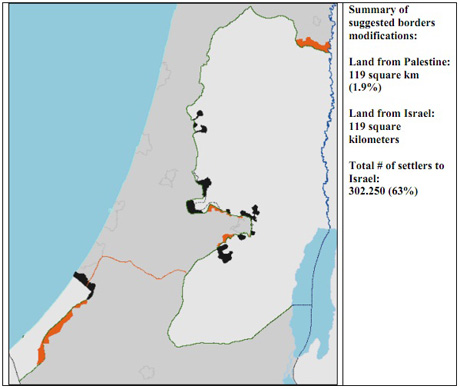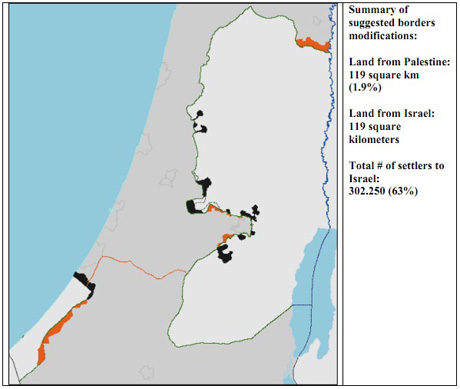
In 2008, then-Israeli Prime Minister Ehud Olmert made the Palestinians an offer so reasonable and enlightened it made Ehud Barak's “generous offer” at Camp David look like the Treaty of Versailles. Bending over backwards to reach a peace settlement, Olmert offered the Palestinians a state on virtually all of the occupied territories. Alas, stubborn as always, Palestinian negotiators turned him down.
Much like Barak's mythical “generous offer”, this account of Olmert's proposal has been widely repeated, conforming as it does to convenient narratives that place the burden for the continuing conflict on the Palestinians, and demonstrating for all to see that, as Abba Eban famously put it, when it comes to peace, the Arabs “never miss an opportunity to miss an opportunity”.
What did Olmert really offer? Thanks to the Palestine Papers – leaked internal Palestinian documents related to the 'peace process' – we don't need to speculate. Palestinian officials kept detailed minutes of meetings with Israeli and American officials to serve as an internal record of where negotiations had got to. In 2008 Olmert made two offers to the Palestinians. In April he proposed that Israel annex 9.2% of the West Bank in exchange for Israeli territory equivalent of 5% of the West Bank. Then on 31 August he offered the Palestinian president Mahmoud Abbas a landswap in which Israel would annex 8.7% of the West Bank in exchange for Israeli territory equivalent of 5.5%. This second 'offer' was not a formal one: Olmert would not allow it to be presented to the broader negotiation teams. The maps he presented were reportedly “similar to the Wall”.
Already it is difficult to see what the fuss is about. Annexing nearly ten percent of the West Bank along roughly the route of the Wall violates basic Palestinian legal rights and renders a viable and contiguous Palestinian state impossible. But it's worse than the mere percentages suggest. The fundamental problem is that Olmert continued to insist on annexing “all the major [settlement] 'blocs'”, keeping 90% of Israeli settlers in place. This is an important point to understand. The settlements themselves – the actual built-up areas – take up almost no space. The problem is that Israel wants to annex, not settlements, but settlement blocs: large chunks of Palestinian territory that link settlements to each other and to Israel proper, dissecting the West Bank into de facto non-contiguous cantons, appropriating key water and agricultural resources, and cutting Palestinians off from East Jerusalem in the process (without East Jerusalem, the West Bank's economic hub, there can be no Palestinian state). Note that this was still Israel's negotiating position in November 2008, after the “secret offer” made by Olmert and recently “revealed” by Condoleeza Rice (a mere two years after it appeared in Ha'aretz) to sell her memoirs.
If Olmert's deal was a non-starter, did the Palestinians offer an alternative? Yes. The Palestinians came up with an official offer that both upheld their legal rights and made reasonable compromises to accommodate Israeli interests. Here's what it looked like:

(Black areas to be annexed to Israel; orange areas to the future Palestinian state)
Note that under this proposal over 60% of Israeli settlers would remain in situ, on just 1.9% of Palestinian territory, which would be exchanged for land of equal size and value inside Israel. As the International Court of Justice unanimously determined, the West Bank (including East Jerusalem) and Gaza constitute occupied Palestinian territory, and all of Israel's settlements are illegal. And yet, this notwithstanding, Palestinian negotiators offered to allow over 60% of them to stay where they are. That's a breathtaking compromise, but one that nonetheless leaves a contiguous West Bank intact to serve as the basis for a viable Palestinian state.
Unlike Olmert's slight modification of Israel's standard rejectionist position, this Palestinian proposal received no media plaudits, and garnered no international praise. Indeed it hasn't even been reported. Also unlike Olmert's 'offer', it represents the basis for a genuine peace settlement. It embodies the overwhelming international political and legal consensus for resolving the conflict, making extraordinary compromises to accommodate Israel's interests while still providing for a contiguous, viable state on the whole of Palestinian territory.
What does a peaceful settlement to the Israel-Palestine conflict look like? It looks like this Palestinian map. It remains for us pressure Israel to accept it.
Join us in defending the truth before it’s too late
The future of independent journalism is uncertain, and the consequences of losing it are too grave to ignore. To ensure Truthout remains safe, strong, and free, we need to raise $50,000 in the next 10 days. Every dollar raised goes directly toward the costs of producing news you can trust.
Please give what you can — because by supporting us with a tax-deductible donation, you’re not just preserving a source of news, you’re helping to safeguard what’s left of our democracy.